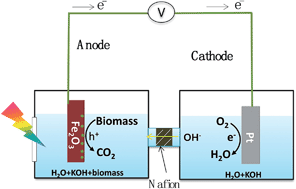Transition metal (Ni, Fe, and Cu) hydroxides enhanced α-Fe2O3 photoanode-based photofuel cell†
Abstract
Photofuel cells have been demonstrated to be a promising strategy for generating electricity using biomass. Here, we present a photofuel cell with a visible light α-Fe2O3 based photoanode that can be directly powered by a variety of biomasses such as methanol, glycerol, glucose, cellubiose and starch. The photocurrent density and power density of the photofuel cell are significantly enhanced by loading cocatalysts (metal hydroxides, e.g. Ni(OH)2) on the α-Fe2O3 photoanode. The power density of the photofuel cell powered by glucose is enhanced over two times from 0.082 mA cm−2 for α-Fe2O3 to 0.18 mW cm−2 for Ni(OH)2/α-Fe2O3 photoanode.


 Please wait while we load your content...
Please wait while we load your content...